DC Link Voltage Enhancement in DC Microgrid Using PV Based High Gain Converter with Cascaded Fuzzy Logic Controller
Abstract
1. Introduction
- A hybrid PV, wind, and ESS-based hybrid DC microgrid system is designed to meet the increasing load demand.
- A high-gain Luo converter with CFLC is proposed to enhance the PV output voltage for providing high-gain outputs, which helps for effective stabilization of the DC link voltage of the Microgrid.
- In addition, with the aid of virtual inertia and damping control approach along with droop control strategy for DFIG-based WECS, DC link voltage is effectively regulated under all operating conditions.
- An ANN-based droop control technique is proposed for ESS to adequately enhance the DC link voltage during insufficient power generation from the PV and WECS.
2. Literature Review
3. Proposed Microgrid and Modelling
3.1. Luo Converter
3.2. Cascaded Fuzzy Logic Controller
3.3. Virtual Inertia and Damping Control
3.4. PI Controller Based Droop Control
3.5. Modelling of the ESS with ANN Based Droop Control
3.5.1. Description of ANN
3.5.2. Structure of Bidirectional Converter with ANN Optimized Droop Control
4. Results and Discussion
4.1. Simulation Results and Analysis
4.1.1. PV System
- Discussion:
4.1.2. DFIG-Based WECS
- Discussion:
4.1.3. Energy Storage System
- Discussion:
4.1.4. Grid Synchronization
5. Hardware Analysis
5.1. FPGA Implementation Flowchart
- A PV (Photovoltaic) Simulator is an electronic device that emulates the behaviour of actual PV panels in a controlled laboratory environment.
- The role of a DFIG module is to convert variable AC power from a wind turbine into stable DC power that can be used by a DC microgrid.
- A wind turbine with a power rating of 1 kW is utilised as an electrical power source in a hardware setup aimed at showcasing the potential of wind energy.
- The ESS 48 V LiFePO4 battery serves as an energy storage solution for a DC microgrid setup. It provides a reliable source of backup power, peak shaving, load shifting, and load balancing, and contributes to the overall sustainability of the microgrid system.
- A 1 kW DC-DC converter, featuring an input voltage range of 85 V and an output voltage range of 600 V, regulates the voltage level, converts power, isolates different parts of the system, and improves the power quality of the overall system.
- The TLP250 driver system plays a crucial role in controlling and managing the power flow between different components of the system.
- A bidirectional 1 kW, 100 Ah DC-DC converter, featuring an input voltage range of 400 V and an output voltage range of 48 V, is designed to convert electrical power from one voltage level to another in both directions.
- A three-phase inverter with a rating of 600 V and 100 A facilitates the conversion of DC power to AC power, enables bi-directional power flow, and provides voltage and frequency regulation to ensure smooth and efficient operation of the microgrid.
- The FPGA Spartan 6 development board can serve as a versatile and flexible hardware platform for implementing control, communication, and management functions in a DC microgrid system.
5.2. Experimental Results
5.2.1. PV System
5.2.2. DFIG-Based WECS
5.2.3. Energy Storage System
5.2.4. Grid Synchronisation
6. Conclusions
Author Contributions
Funding
Data Availability Statement
Conflicts of Interest
References
- Qazi, A.; Hussain, F.; Rahim, N.A.; Hardaker, G.; Alghazzawi, D.; Shaban, K.; Haruna, K. Towards Sustainable Energy: A Systematic Review of Renewable Energy Sources, Technologies, and Public Opinions. IEEE Access 2019, 7, 63837–63851. [Google Scholar] [CrossRef]
- Son, Y.; Mukherjee, S.; Mallik, R.; Majmunovi’c, B.; Dutta, S.; Johnson, B.; Maksimović, D.; Seo, G.S. Levelized Cost of Energy-Oriented Modular String Inverter Design Optimization for PV Generation System using Geometric Programming. IEEE Access 2022, 10, 27561–27578. [Google Scholar] [CrossRef]
- Chaudhuri, A.; Datta, R.; Kumar, M.P.; Davim, J.P.; Pramanik, S. Energy Conversion Strategies for Wind Energy System: Electrical, Mechanical and Material Aspects. Materials 2022, 15, 1232. [Google Scholar] [CrossRef] [PubMed]
- Meng, L.; Shafiee, Q.; Trecate, G.F.; Karimi, H.; Fulwani, D.; Lu, X.; Guerrero, J.M. Review on control of DC microgrids and multiple microgrid clusters. IEEE J. Emerg. Sel. Top. Power Electron. 2017, 5, 928–948. [Google Scholar] [CrossRef]
- Kumar, D.; Zare, F.; Ghosh, A. DC Microgrid Technology: System Architectures, AC Grid Interfaces, Grounding Schemes, Power Quality, Communication Networks, Applications, and Standardisations Aspects. IEEE Access 2017, 5, 12230–12256. [Google Scholar] [CrossRef]
- Al-Ismail, F.S. DC Microgrid Planning, Operation, and Control: A Comprehensive Review. IEEE Access 2021, 9, 36154–36172. [Google Scholar] [CrossRef]
- Ahmed, M.; Meegahapola, L.; Vahidnia, A.; Datta, M. Stability and Control Aspects of Microgrid Architectures–A Comprehensive Review. IEEE Access 2020, 8, 144730–144766. [Google Scholar] [CrossRef]
- Tang, Z.; Yang, Y.; Blaabjerg, F. Power Electronics: The Enabling Technology for Renewable Energy Integration. CSEE J. Power Energy Syst. 2022, 8, 39–52. [Google Scholar] [CrossRef]
- Karafil, A.; Ozbay, H.; Oncu, S. Design and Analysis of Single-Phase Grid-Tied Inverter with PDM MPPT-Controlled Converter. IEEE Trans. Power Electron. 2020, 35, 4756–4766. [Google Scholar] [CrossRef]
- Kumar, R.; Singh, B. BLDC Motor-Driven Solar PV Array-Fed Water Pumping System Employing Zeta Converter. IEEE Trans. Ind. Appl. 2016, 52, 2315–2322. [Google Scholar] [CrossRef]
- Bao, D.; Kumar, A.; Pan, X.; Xiong, X.; Beig, A.R.; Singh, S.K. Switched Inductor Double Switch High Gain DC-DC Converter for Renewable Applications. IEEE Access 2021, 9, 14259–14270. [Google Scholar] [CrossRef]
- Tey, K.S.; Mekhilef, S.; Seyedmahmoudian, M.; Horan, B.; Oo, A.T.; Stojcevski, A. Improved Differential Evolution-Based MPPT Algorithm using SEPIC for PV Systems under Partial Shading Conditions and Load Variation. IEEE Trans. Ind. Inform. 2018, 14, 4322–4333. [Google Scholar] [CrossRef]
- de Morais, J.C.D.S.; de Morais, J.L.D.S.; Gules, R. Photovoltaic AC Module based on a Cuk Converter with a Switched-Inductor Structure. IEEE Trans. Ind. Electron. 2019, 66, 3881–3890. [Google Scholar] [CrossRef]
- Rana, N.; Banerjee, S. Development of an Improved Input-Parallel Output-Series Buck-Boost Converter and Its Closed-Loop Control. IEEE Trans. Ind. Electron. 2020, 67, 6428–6438. [Google Scholar] [CrossRef]
- Singh, B.; Kushwaha, R. Power Factor Preregulation in Interleaved Luo Converter-Fed Electric Vehicle Battery Charger. IEEE Trans. Ind. Appl. 2021, 57, 2870–2882. [Google Scholar] [CrossRef]
- Alturki, F.A.; Omotoso, H.O.; Al-Shamma’a, A.A.; Farh, H.M.; Alsharabi, K. Novel Manta Rays Foraging Optimization Algorithm based Optimal Control for Grid-Connected PV Energy System. IEEE Access 2020, 8, 187276–187290. [Google Scholar] [CrossRef]
- Ali, M.; Tariq, M.; Lodi, K.A.; Chakrabortty, R.K.; Ryan, M.J.; Alamri, B.; Bharatiraja, C. Robust ANN-based Control of Modified PUC-5 Inverter for Solar PV Applications. IEEE Trans. Ind. Appl. 2021, 57, 3863–3876. [Google Scholar] [CrossRef]
- Yap, K.Y.; Beh, C.M.; Sarimuthu, C.R. Fuzzy Logic Controller-based Synchronverter in Grid-Connected Solar Power System with Adaptive Damping Factor. Chin. J. Electr. Eng. 2021, 7, 37–49. [Google Scholar] [CrossRef]
- Singh, R.; Bansal, R.C. Optimisation of an Autonomous Hybrid Renewable Energy System using Reformed Electric System Cascade Analysis. IEEE Trans. Ind. Inform. 2019, 15, 399–409. [Google Scholar] [CrossRef]
- Muralikumar, K.; and Ponnambalam, P. Comparison of Fuzzy and ANFIS Controllers for Asymmetrical 31-Level Cascaded Inverter with Super Imposed Carrier PWM Technique. IEEE Access 2021, 9, 82630–82646. [Google Scholar] [CrossRef]
- Hu, J.; Huang, Y.; Wang, D.; Yuan, H.; Yuan, X. Modeling of Grid-Connected DFIG-Based Wind Turbines for DC-Link Voltage Stability Analysis. IEEE Trans. Sustain. Energy 2015, 6, 1325–1336. [Google Scholar] [CrossRef]
- Tan, J.D.; Chang, C.C.W.; Bhuiyan, M.A.S.; Nisa’Minhad, K.; Ali, K. Advancements of Wind Energy Conversion Systems for Low-wind Urban Environments: A review. Energy Rep. 2022, 8, 3406–3414. [Google Scholar] [CrossRef]
- Zhu, X.; Meng, F.; Xie, Z.; Yue, Y. An Inertia and Damping Control Method of DC-DC Converter in DC Microgrids. IEEE Trans. Energy Convers. 2019, 35, 799–807. [Google Scholar] [CrossRef]
- Li, G.; Du, Z.; Shen, C.; Yuan, Z.; Wu, G. Coordinated Design of Droop Control in MTDC Grid Based on Model Predictive Control. IEEE Trans. Power Syst. 2017, 33, 2816–2828. [Google Scholar] [CrossRef]
- Lu, X.; Sun, K.; Guerrero, J.M.; Vasquez, J.C.; Huang, L.; Wang, J. Stability Enhancement based on Virtual Impedance for DC Microgrids with Constant Power Loads. IEEE Trans. Smart Grid 2015, 6, 2770–2783. [Google Scholar] [CrossRef]
- Wu, W.; Chen, Y.; Luo, A.; Zhou, L.; Zhou, X.; Yang, L.; Dong, Y.; and Guerrero, J.M. A Virtual Inertia Control Strategy for DC Microgrids Analogized with Virtual Synchronous Machines. IEEE Trans. Ind. Electron. 2016, 64, 6005–6016. [Google Scholar] [CrossRef]
- Peng, Q.; Yang, Y.; Liu, T.; Blaabjerg, F. Coordination of Virtual Inertia Control and Frequency Damping in PV Systems for Optimal Frequency Support. CPSS Trans. Power Electron. Appl. 2020, 5, 305–316. [Google Scholar] [CrossRef]
- Li, X.; Wang, S. Energy Management and Operational Control Methods for Grid Battery Energy Storage Systems. CSEE J. Power Energy Syst. 2021, 7, 1026–1040. [Google Scholar] [CrossRef]
- Unamuno, E.; Barrena, J.A. Design and Small-Signal Stability Analysis of a Virtual-Capacitor Control for DC Microgrids. In Proceedings of the 2017 19th European Conference on Power Electronics and Applications (EPE’17 ECCE Europe), Warsaw, Poland, 11–14 September 2017; p. 1. [Google Scholar] [CrossRef]
- Jin, Z.; Meng, L.; Han, R.; Guerrero, J.M.; Vasquez, J.C. Admittance-Type RC-Mode Droop Control to Introduce Virtual Inertia in Dc Microgrids. In Proceedings of the 2017 IEEE Energy Conversion Congress and Exposition (ECCE), Cincinnati, OH, USA, 1–5 October 2017; pp. 4107–4112. [Google Scholar] [CrossRef]
- Oh, S.K.; Kim, W.D.; Pedrycz, W. Design of Optimized Cascade Fuzzy Controller based on Differential Evolution: Simulation Studies and Practical Insights. Eng. Appl. Artif. Intell. 2012, 25, 520–532. [Google Scholar] [CrossRef]
- Zhu, X.; Xie, Z.; Jing, S.; Ren, H. Distributed Virtual Inertia Control and Stability Analysis of DC Microgrid. IET Gener. Transm. Distrib. 2018, 12, 3477–3486. [Google Scholar] [CrossRef]
- Effendy, M.; Ashari, M.; Suryoatmojo, H. Performance Comparison of Proportional-Integral and Fuzzy-PI for a Droop Control of DC Microgrid. In Proceedings of the 2020 International Conference on Sustainable Energy Engineering and Application (ICSEEA), Tangerang, Indonesia, 18–20 November 2020; pp. 180–184. [Google Scholar] [CrossRef]
- Dong, W.; Li, S.; Fu, X. Artificial Neural Network Control of a Standalone DC Microgrid. In Proceedings of the 2018 Clemson University Power Systems Conference (PSC), Pickens County, SC, USA, 1 September 2018; pp. 1–5. [Google Scholar] [CrossRef]
- Nejabatkhah, F.; Danyali, S.; Hosseini, S.H.; Sabahi, M.; Niapour, S.M. Modeling and Control of a New Three-Input DC–DC Boost Converter for Hybrid PV/FC/Battery Power System. IEEE Trans. Power Electron. 2011, 27, 2309–2324. [Google Scholar] [CrossRef]
- Galea, F.; Apap, M.; Spiteri Staines, C.; Cilia, J. Design of a High Efficiency Wide Input Range Isolated Cuk DC-DC Converter for Grid Connected Regenerative Active Loads. World Eng. Conv. 2011. Available online: https://www.um.edu.mt/library/oar/handle/123456789/27424 (accessed on 1 September 2011).
- Javeed, P.; Yadav, L.K.; Kumar, P.V.; Kumar, R.; Swaroop, S. SEPIC Converter for Low Power LED Applications. J. Phys. Conf. Ser. 2021, 1818, 012220. [Google Scholar] [CrossRef]
- Rajeswari, R.V.; Geetha, A. Comparison of Buck-Boost and CUK Converter Control using Fuzzy Logic Controller. Int. J. Innov. Res. Sci. Eng. Technol. 2014, 3, 63806788. [Google Scholar]
- Yilmaz, M.; Corapsiz, M.; Çorapsiz, M.R. Voltage Control of Cuk Converter with PI and Fuzzy Logic Controller in Continuous Current Mode. Balk. J. Electr. Comput. Eng. 2020, 8, 127–134. [Google Scholar] [CrossRef]



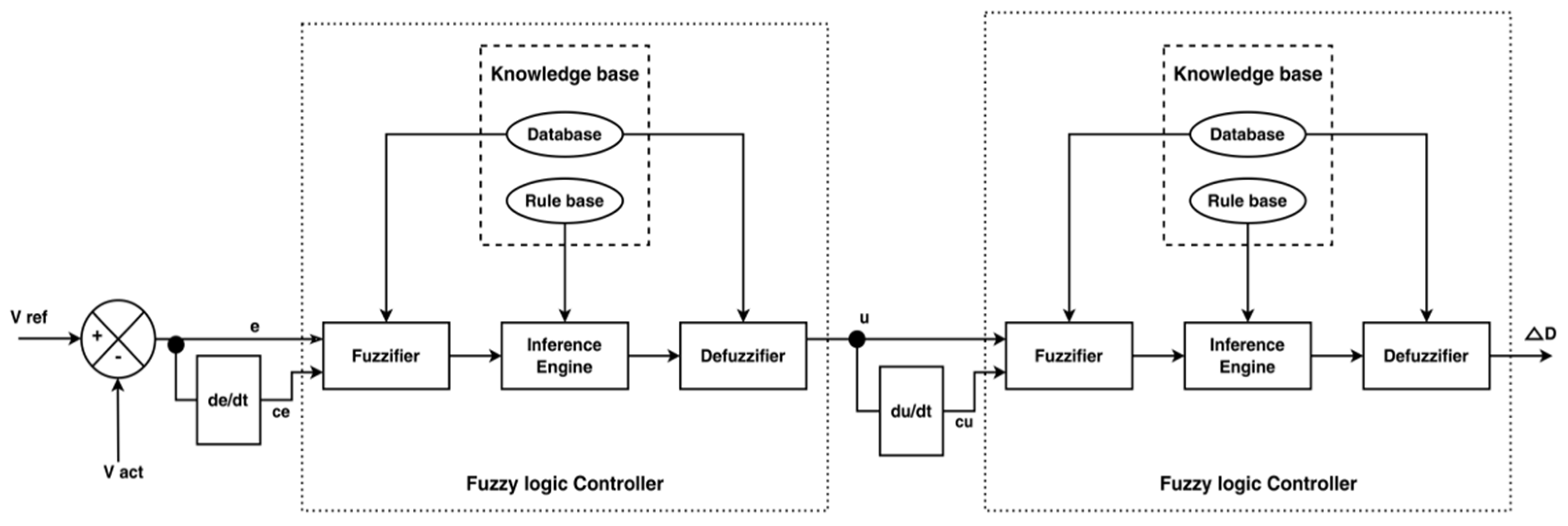




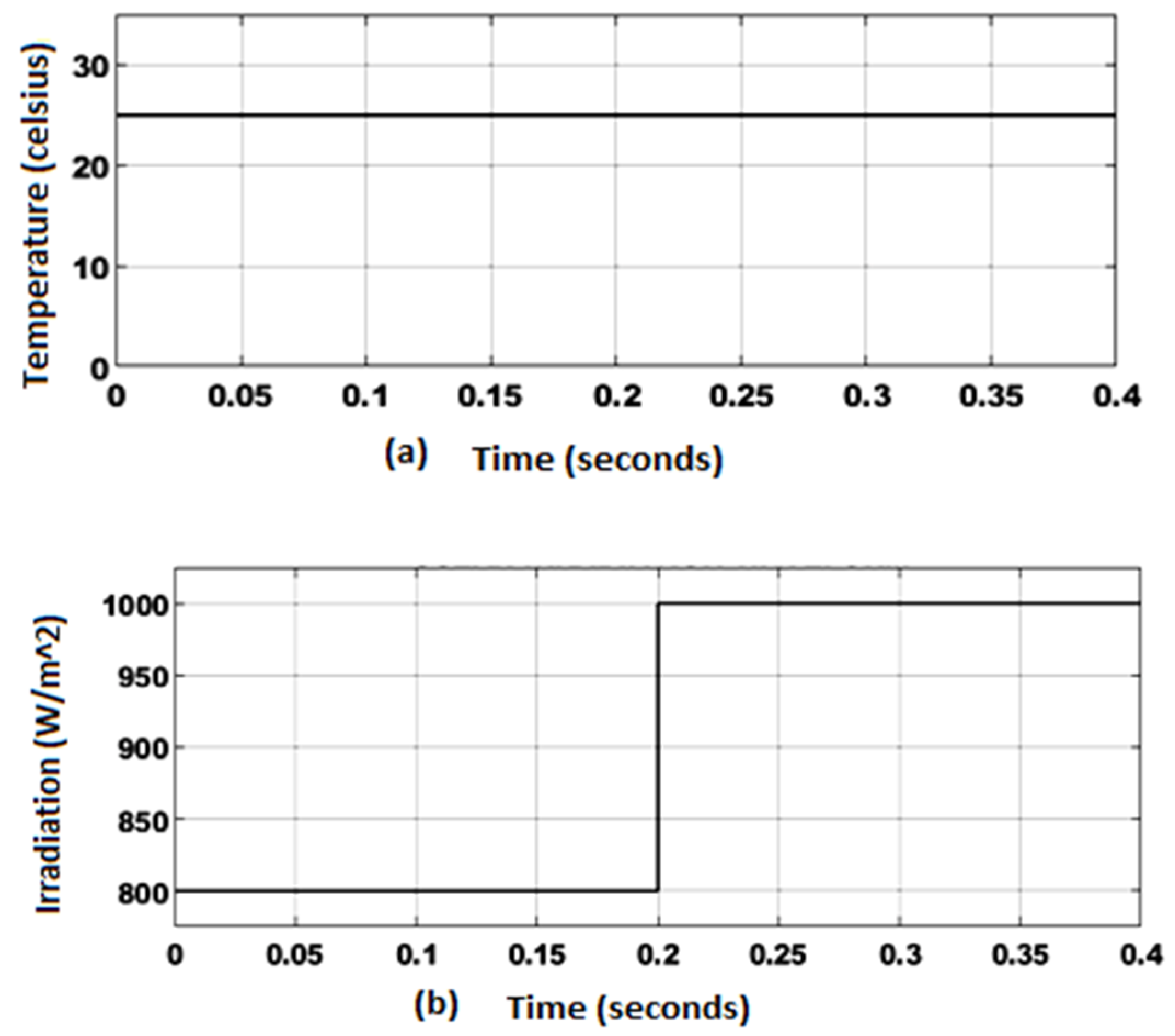


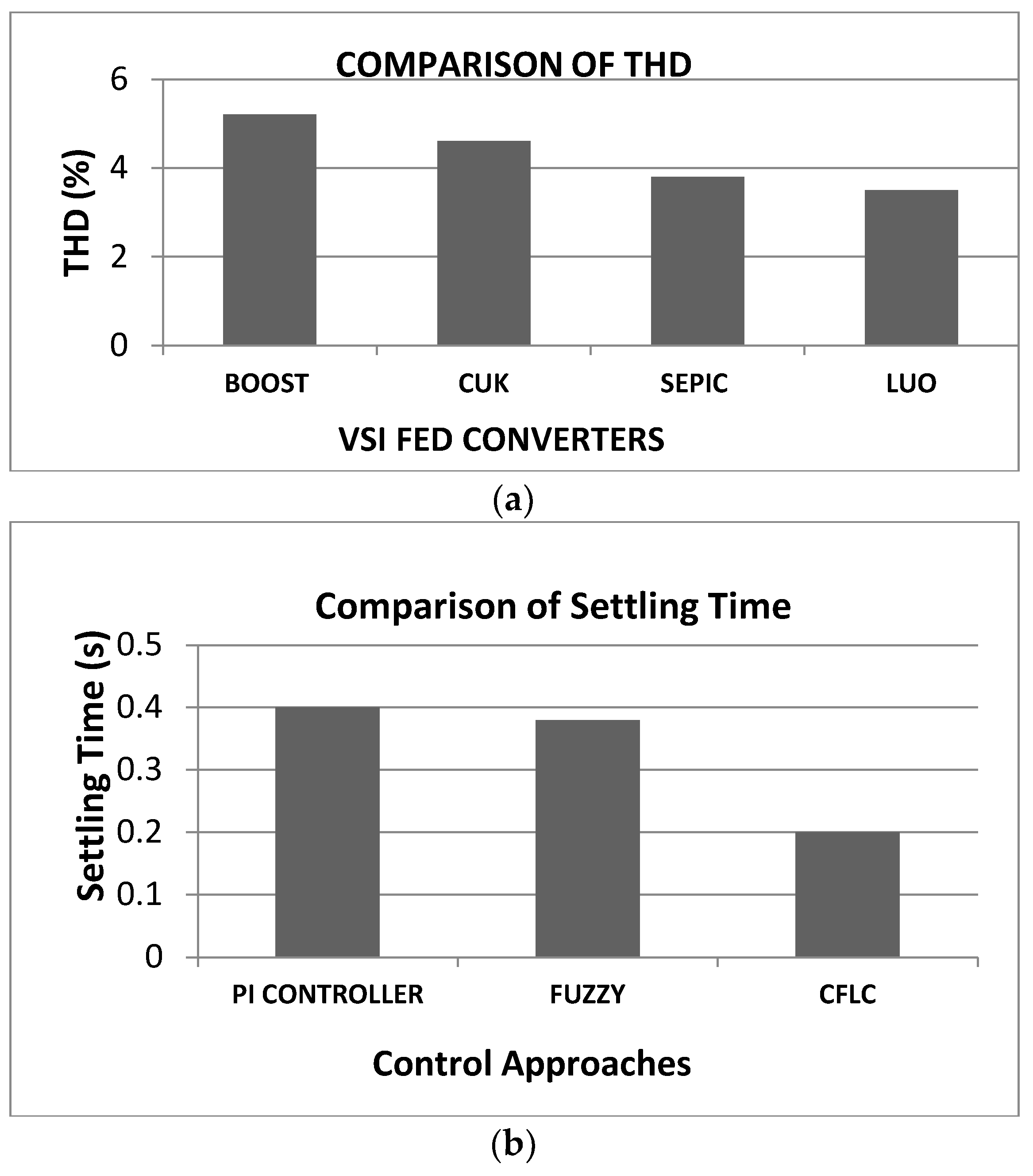
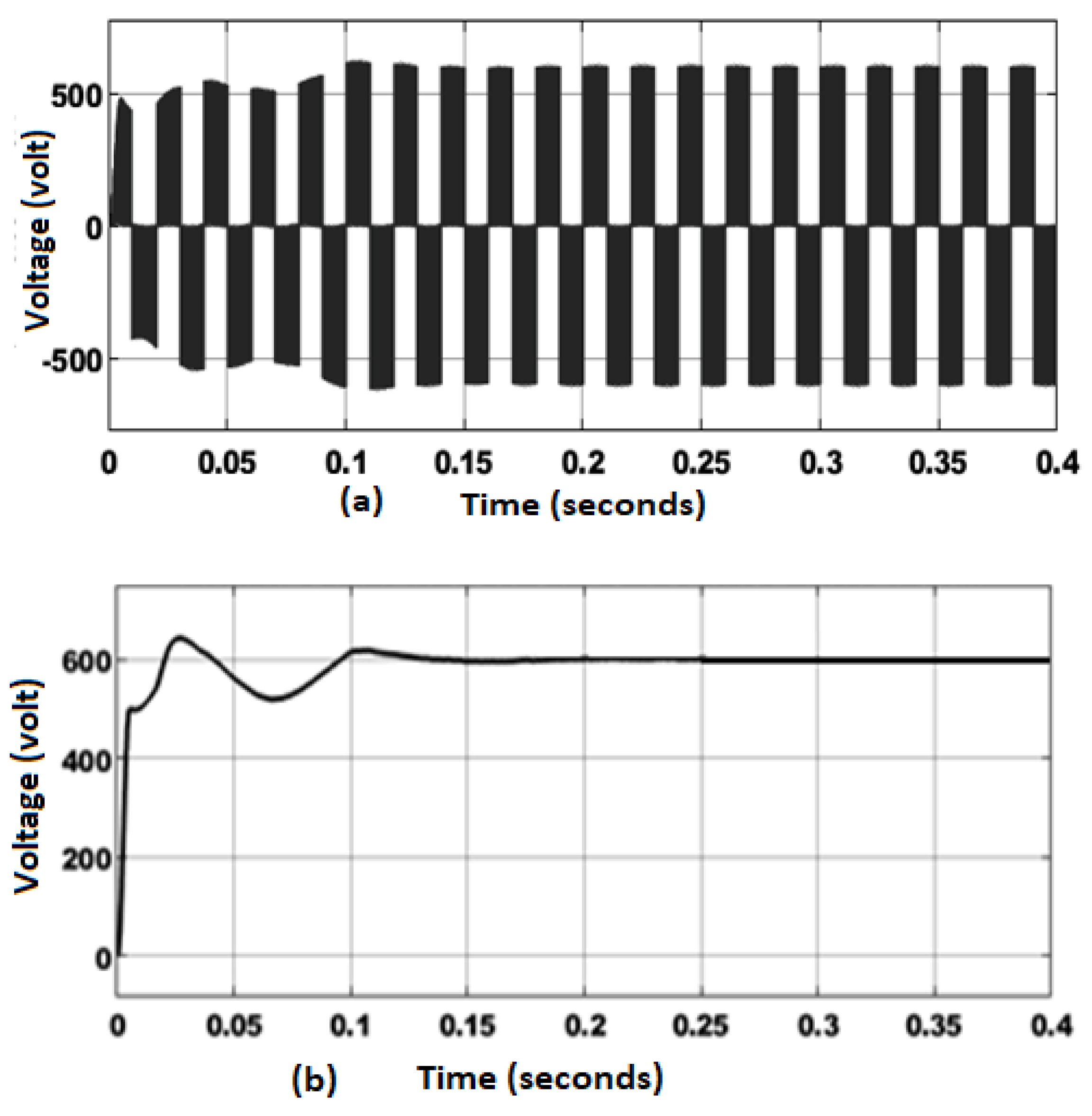



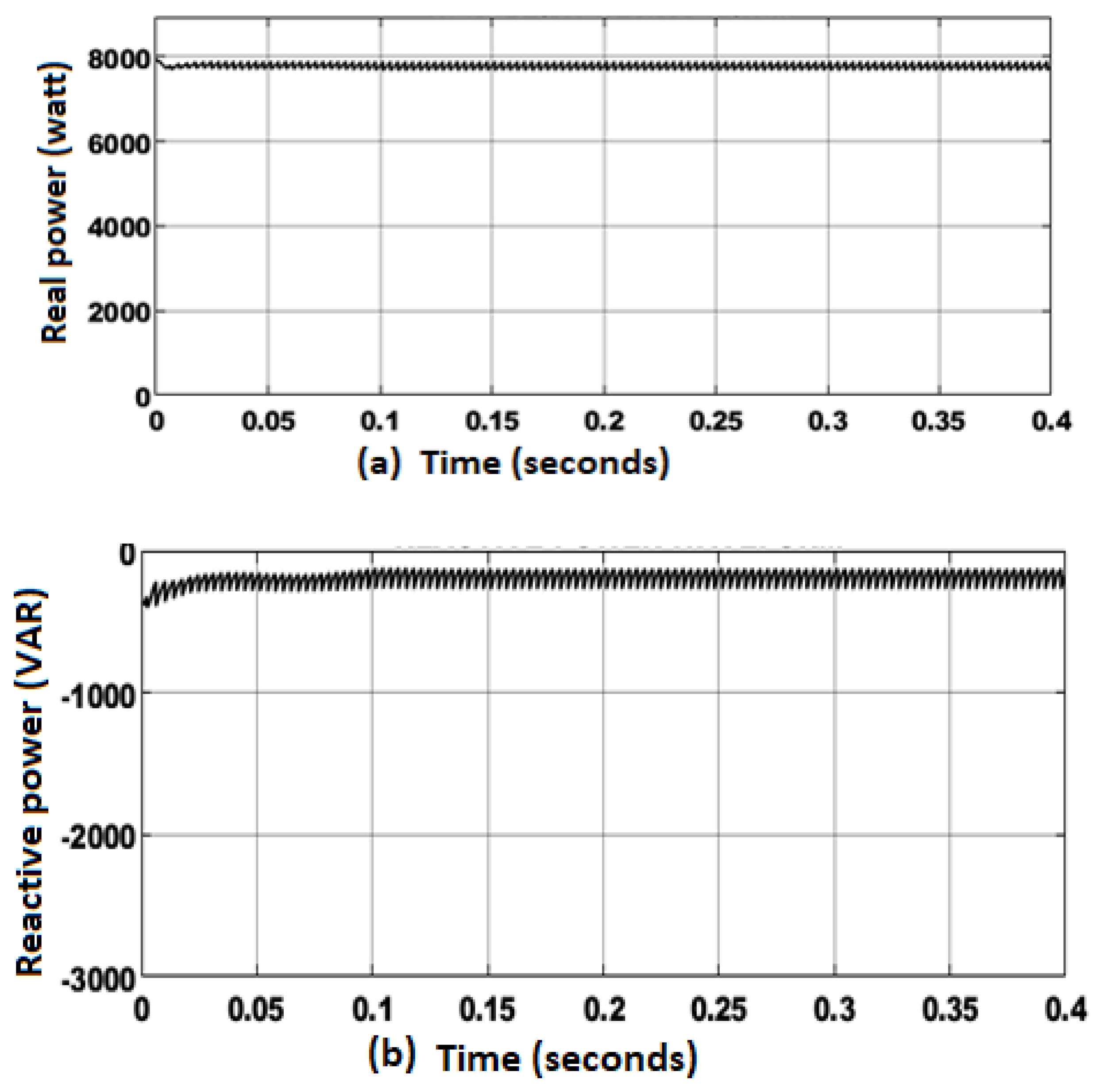


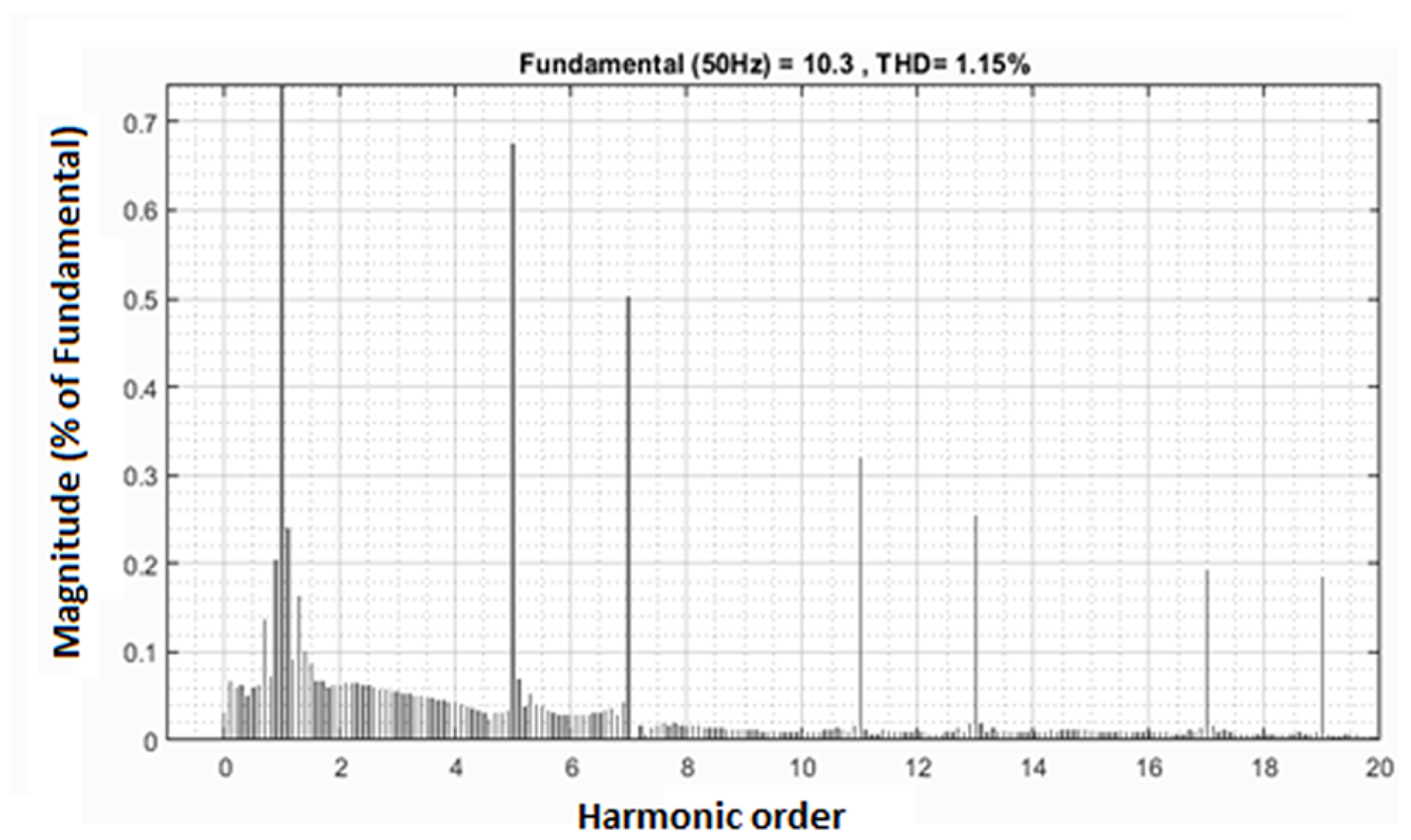
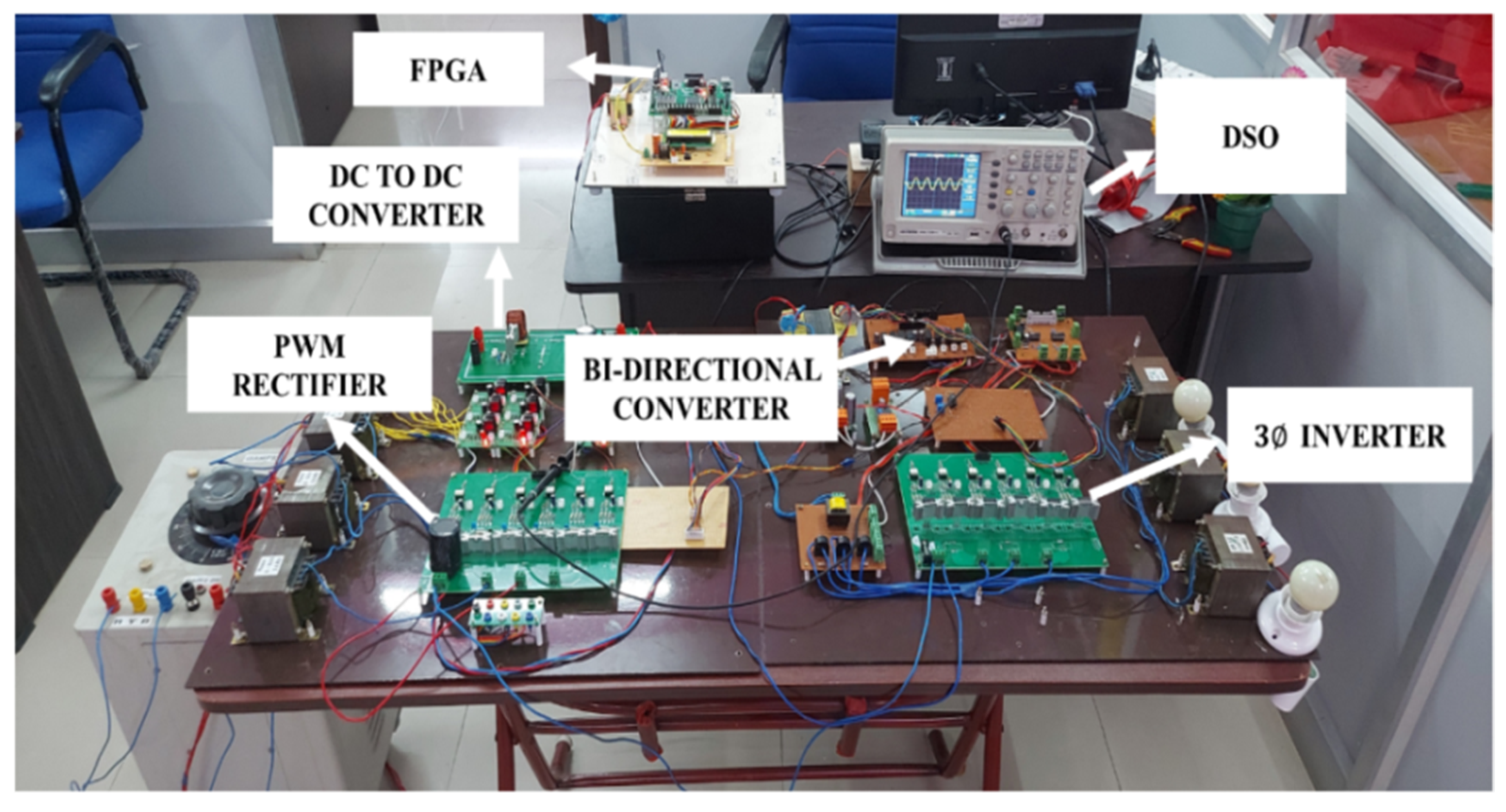
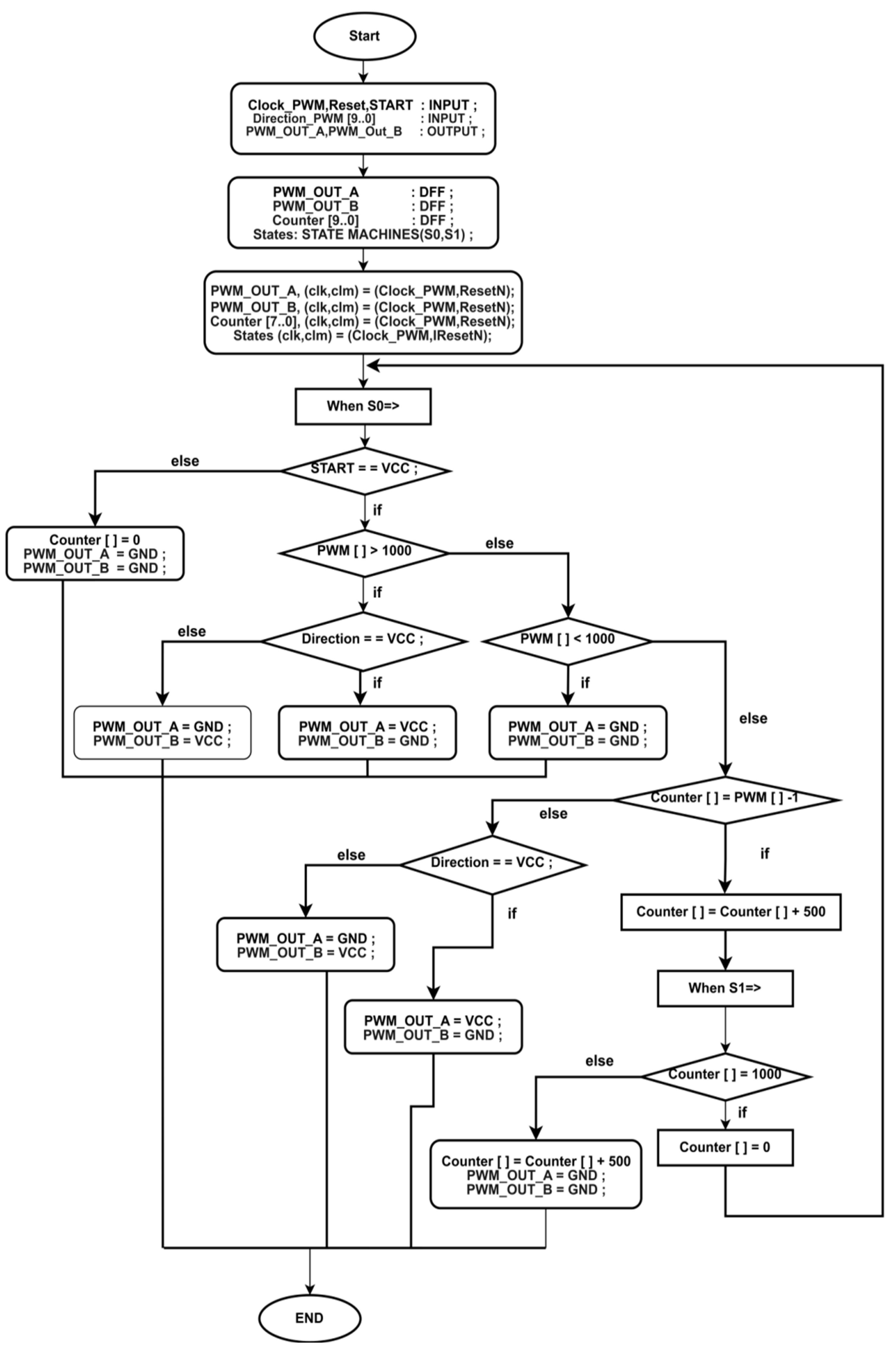







| References | Methodology | Advantage | Drawbacks | Limitations | Merits of Proposed Approach |
|---|---|---|---|---|---|
| [10] | PV fed Zeta converter with incremental conductance. | Improved performance under dynamic conditions. | Requires tracking time; small pulsation occurs in the system. | Efficiency is not so high. | Converter aids in high efficiency. |
| [12] | SEPIC with differential evolution algorithm | Good tracking of power is carried out | Design is not so simple; the Control approach relies on the tuning process. | Considers only partially shaded conditions. | Results in improved convergence rate. |
| [16] | PI controller. | Simple in nature. | Controller value is affected by non-linear nature of PV system; tuning parameter values may lead to errors. | Performance is limited to small load disturbances. | Performance is robust to variations in load. |
| [20] | Fuzzy controller. | Handles non-linearity well. | Handles inaccurate data dependent on human intelligence. | Efficiency is not so high. | Improved efficiency is attained. |
| [26] | Virtual inertia control strategy is implemented through Voltage Source Converter (VSC). | Inertia of grid is improved. Voltage instability by RES and load is minimized by inject/extract of current by VSC. | Inertia is small; fluctuations may occur. | Effective only in grid-connected mode. | Effective in both islanding and grid-connected mode. |
| [29] | For a DC Microgrid, a virtual capacitor control is proposed. | By varying the virtual capacitor, the voltage change rate is minimised. | Passive elements influence stability. Sensitivity has to be analysed to determine optimal values. | Voltage stability is not so effective. | Desired dc voltage dynamic performance is achieved. |
| [30] | Admittance type droop control, virtual inertia control. | Droop curve swings are maintained within the range. | System behavior does not meet the expectation, Resonant occurs. | For WECS, this approach is not applicable. | Proposed approach applies to WECS. |
| Solar Panel | |||
|---|---|---|---|
| Parameters | Ratings | Parameters | Ratings |
| Peak power | Diode saturation current (Ido) | ||
| Capacity | 500 W | Cells linked in series (ηSE) | |
| No. of Panels | Diode thermal voltage (vtr) | ||
| ) | Diode Ideality constant (α) | ||
| ) | Boltzmann constant (k) | ||
| ) | Electron charge (q) | ||
| Luo Converter | |||
|---|---|---|---|
| Power Rating | |||
| Duty cycle | |||
| Switching frequency | |||
| Converters | Boost [35] | Cuk [36] | SEPIC [37] | Luo with CFLC |
|---|---|---|---|---|
| Operating duty cycle | 0.35 | 0.75 | 0.88 | 0.87 |
| Efficiency (%) | 80 | 85 | 88.82 | 92 |
| WECS | Buck Converter | ||
|---|---|---|---|
| Power | |||
| Voltage | |||
| Inertia Constant | Switching frequency | ||
| Load | Power Rating | ||
| DC Load | Duty cycle | ||
| Parameters | Droop Control without Virtual Inertia and Damping Control | Droop Control with Virtual Inertia and Damping Control |
|---|---|---|
| Settling time (ts) |
| Components | Specification/Rating | Manufacturer’s Details |
|---|---|---|
| PV Simulator | 1 kW | ITECH Electronics Co., Ltd. |
| DFIG | 1 kW | Ingeteam Power Tech India Ltd. |
| Wind Turbine | 1 kW | RRB Energy Limited (India) |
| ESS | 48 V Lithium Iron Phosphate Battery | Maxworld Power Technologies |
| DC-DC Converter | 1 kW DC-DC Converter, 85 V/600 V | Artesyn Embedded Technology |
| Driver System | Tlp250 | Toshiba Electronic Corporation |
| Bidirectional Converter | 1 kW 100 Ah Bidirectional DC-DC Converter, 400 V, 48 V | Mornsun Power |
| 600 V, 100 A | Ecosys Efficiencies Pvt. Ltd. | |
| FPGA | Spartan 6 development board | FPGA Tech Solution |
| DSO | 30 MHz | Scientech Technologies |
Disclaimer/Publisher’s Note: The statements, opinions and data contained in all publications are solely those of the individual author(s) and contributor(s) and not of MDPI and/or the editor(s). MDPI and/or the editor(s) disclaim responsibility for any injury to people or property resulting from any ideas, methods, instructions or products referred to in the content. |
© 2023 by the authors. Licensee MDPI, Basel, Switzerland. This article is an open access article distributed under the terms and conditions of the Creative Commons Attribution (CC BY) license (https://creativecommons.org/licenses/by/4.0/).
Share and Cite
Rajendran, S.; Thangavel, V.; Krishnan, N.; Prabaharan, N. DC Link Voltage Enhancement in DC Microgrid Using PV Based High Gain Converter with Cascaded Fuzzy Logic Controller. Energies 2023, 16, 3928. https://doi.org/10.3390/en16093928
Rajendran S, Thangavel V, Krishnan N, Prabaharan N. DC Link Voltage Enhancement in DC Microgrid Using PV Based High Gain Converter with Cascaded Fuzzy Logic Controller. Energies. 2023; 16(9):3928. https://doi.org/10.3390/en16093928
Chicago/Turabian StyleRajendran, Senthilnathan, Vigneysh Thangavel, Narayanan Krishnan, and Natarajan Prabaharan. 2023. "DC Link Voltage Enhancement in DC Microgrid Using PV Based High Gain Converter with Cascaded Fuzzy Logic Controller" Energies 16, no. 9: 3928. https://doi.org/10.3390/en16093928
APA StyleRajendran, S., Thangavel, V., Krishnan, N., & Prabaharan, N. (2023). DC Link Voltage Enhancement in DC Microgrid Using PV Based High Gain Converter with Cascaded Fuzzy Logic Controller. Energies, 16(9), 3928. https://doi.org/10.3390/en16093928







